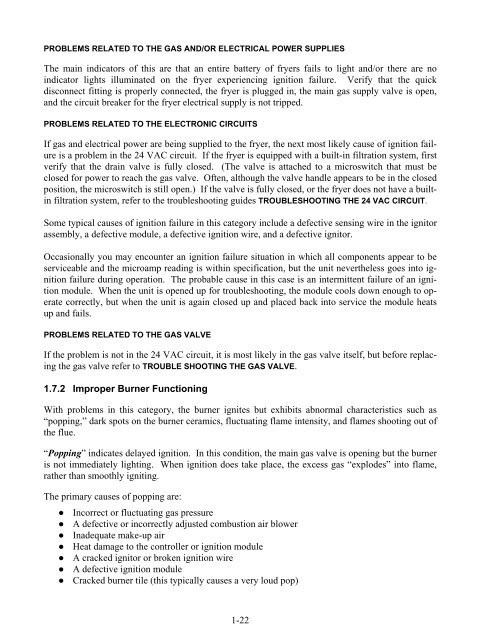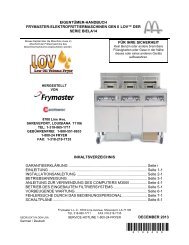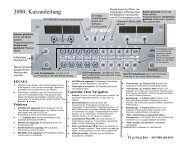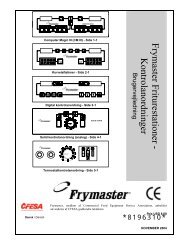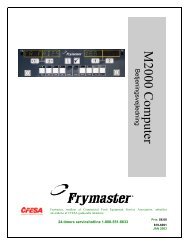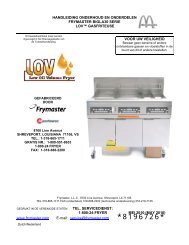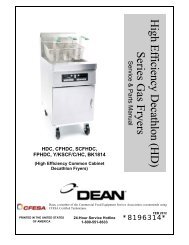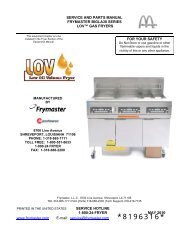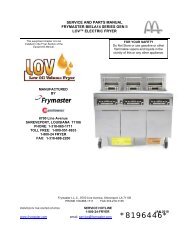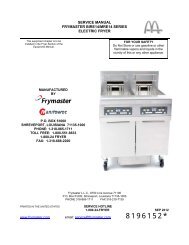819-0001 JUN 07.pdf - Frymaster
819-0001 JUN 07.pdf - Frymaster
819-0001 JUN 07.pdf - Frymaster
You also want an ePaper? Increase the reach of your titles
YUMPU automatically turns print PDFs into web optimized ePapers that Google loves.
PROBLEMS RELATED TO THE GAS AND/OR ELECTRICAL POWER SUPPLIES<br />
The main indicators of this are that an entire battery of fryers fails to light and/or there are no<br />
indicator lights illuminated on the fryer experiencing ignition failure. Verify that the quick<br />
disconnect fitting is properly connected, the fryer is plugged in, the main gas supply valve is open,<br />
and the circuit breaker for the fryer electrical supply is not tripped.<br />
PROBLEMS RELATED TO THE ELECTRONIC CIRCUITS<br />
If gas and electrical power are being supplied to the fryer, the next most likely cause of ignition failure<br />
is a problem in the 24 VAC circuit. If the fryer is equipped with a built-in filtration system, first<br />
verify that the drain valve is fully closed. (The valve is attached to a microswitch that must be<br />
closed for power to reach the gas valve. Often, although the valve handle appears to be in the closed<br />
position, the microswitch is still open.) If the valve is fully closed, or the fryer does not have a builtin<br />
filtration system, refer to the troubleshooting guides TROUBLESHOOTING THE 24 VAC CIRCUIT.<br />
Some typical causes of ignition failure in this category include a defective sensing wire in the ignitor<br />
assembly, a defective module, a defective ignition wire, and a defective ignitor.<br />
Occasionally you may encounter an ignition failure situation in which all components appear to be<br />
serviceable and the microamp reading is within specification, but the unit nevertheless goes into ignition<br />
failure during operation. The probable cause in this case is an intermittent failure of an ignition<br />
module. When the unit is opened up for troubleshooting, the module cools down enough to operate<br />
correctly, but when the unit is again closed up and placed back into service the module heats<br />
up and fails.<br />
PROBLEMS RELATED TO THE GAS VALVE<br />
If the problem is not in the 24 VAC circuit, it is most likely in the gas valve itself, but before replacing<br />
the gas valve refer to TROUBLE SHOOTING THE GAS VALVE.<br />
1.7.2 Improper Burner Functioning<br />
With problems in this category, the burner ignites but exhibits abnormal characteristics such as<br />
“popping,” dark spots on the burner ceramics, fluctuating flame intensity, and flames shooting out of<br />
the flue.<br />
“Popping” indicates delayed ignition. In this condition, the main gas valve is opening but the burner<br />
is not immediately lighting. When ignition does take place, the excess gas “explodes” into flame,<br />
rather than smoothly igniting.<br />
The primary causes of popping are:<br />
● Incorrect or fluctuating gas pressure<br />
● A defective or incorrectly adjusted combustion air blower<br />
● Inadequate make-up air<br />
● Heat damage to the controller or ignition module<br />
● A cracked ignitor or broken ignition wire<br />
● A defective ignition module<br />
● Cracked burner tile (this typically causes a very loud pop)<br />
1-22


